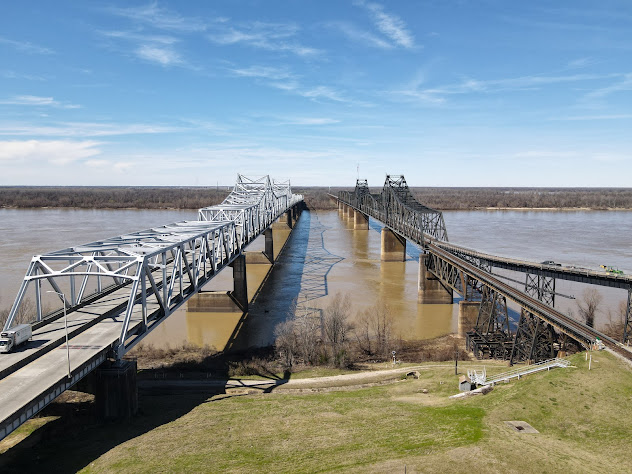Welcome to the gateway page for Gribblenation’s series on the bridges of the lower Mississippi River in Vicksburg, MS! Here you will find links to information about the two bridges that span the river at the historic city of Vicksburg. The bridges of Vicksburg were constructed during the period between the early automobile era of the 1920s and the height of the modern interstate highway era of the 1970s. Each has a unique story to tell and they play a vital part in the transportation system of the Mississippi Delta region.
Cover Photo: From left to right, the Vicksburg Bridge (1973) and the Old Vicksburg Bridge (1930) combine to create one of the most impressive bridge-related visuals on the lower Mississippi River.
Old Vicksburg Bridge
The Old Vicksburg Bridge was built in 1930 and was among the first railroad bridges built across the lower Mississippi River. It's unique deck design enabled both road and rail traffic to share deck space adjacent to one another through the steel cantilever truss superstructure.
How To Get There:
Bridges, Crossings, and Structures of the Lower Mississippi River
Return to the Bridges of the Lower Mississippi River Home Page
__________________________________________________
Cover Photo: From left to right, the Vicksburg Bridge (1973) and the Old Vicksburg Bridge (1930) combine to create one of the most impressive bridge-related visuals on the lower Mississippi River.
Old Vicksburg Bridge
The Old Vicksburg Bridge was built in 1930 and was among the first railroad bridges built across the lower Mississippi River. It's unique deck design enabled both road and rail traffic to share deck space adjacent to one another through the steel cantilever truss superstructure.
Vicksburg Bridge
The Vicksburg Bridge was built immediately downriver in 1973 and is part of Interstate 20 and US Highway 80, the latter relocating off it's long standing alignment on the "old" bridge to the more modern "new" bridge.
Links to Gribblenation Articles:
Old Vicksburg Bridge (1930)
Vicksburg Bridge (1973)
Vicksburg's Mississippi River Bridges
The Vicksburg Bridge was built immediately downriver in 1973 and is part of Interstate 20 and US Highway 80, the latter relocating off it's long standing alignment on the "old" bridge to the more modern "new" bridge.
Links to Gribblenation Articles:
Old Vicksburg Bridge (1930)
Vicksburg Bridge (1973)
Vicksburg's Mississippi River Bridges
Bridges, Crossings, and Structures of the Lower Mississippi River
Return to the Bridges of the Lower Mississippi River Home Page
__________________________________________________




Comments